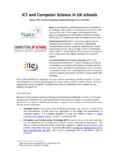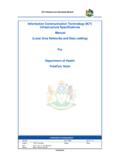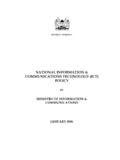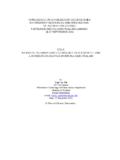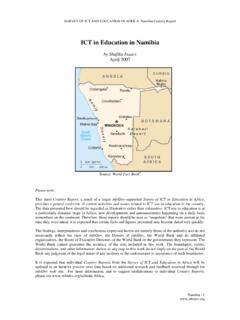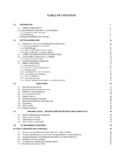Transcription of School ICT Infrastructure Requirements for Teaching Computing
1 School ICT Infrastructure Requirements for Teaching Computing A Computing at School (CAS) Whitepaper By Brian Lockwood and Richard Cornell September 2013 FINAL School ICT Infrastructure Requirements for Teaching Computing Version Page 2 of 37 Table of Contents 1 Executive Summary .. 3 Recommendations .. 4 2 Introduction .. 6 Definitions .. 7 3 Requirements and Challenges of Teachers and Learners .. 8 Programming Languages .. 8 Workstation and Network Environment .. 8 Access to files .. 9 Hardware .. 9 Operating Systems .. 9 Infrastructure Challenges for Teachers .. 9 4 Requirements and Challenges of Infrastructure Service Providers .. 12 What Are the Risks to the Service Provider? .. 12 Reducing Risk .. 14 5 School Management Issues and Potential Solutions .. 15 Key Roles .. 15 The ICT Infrastructure .. 16 Sources of Conflict and Possible Solutions .. 16 A Strategy for Computer Science .. 17 Acceptable Use .. 18 A Risk Based Approach.
2 18 Change Control .. 19 6 Possible Technical 21 7 Table of Possible Technical Solutions .. 22 Preventing the Running of Executable Files .. 31 Access to the Command Line Interface .. 31 8 Appendix 1 AS/A Level Computing Requirements .. 33 AQA AS/A Level Computing Requirements .. 33 9 Appendix 2 Case Study .. 34 Queen Elizabeth School , Cumbria .. 34 10 Appendix 3 Acceptable Use Policy .. 36 11 Appendix 4 Sources of Help and Advice .. 37 FINAL School ICT Infrastructure Requirements for Teaching Computing Version Page 3 of 37 1 Executive Summary School ICT Infrastructure and how it is managed can be one the biggest impediments in the implementation of Computer Science education. The needs of teachers and learners and the Requirements imposed on network managers, whether in-house or outsourced, can be a source of conflict. The sometimes apparently diametrically opposing position of the service provider and their end users has always been there and it applies to the Teaching of other subjects not just Computer Science or ICT.
3 The introduction of Computer Science as an academic subject adds a further layer of complication to the challenging landscape of School IT Infrastructure . Without the right support and information, School IT Infrastructure cannot deliver the processing power and networking facilities that students need for computer science without compromising security or integrity of the other users on the system or their data. With good training and management, in-house and third party service providers can support the specialist needs of all teachers. This will mean that teachers do not have to struggle with a system that is heavily tied down because the necessary protections are implemented correctly and they function quietly in the background. The experience from many CAS members has shown that it is possible to teach Computer Science with support from senior leadership, a constructive dialog with the service provider and the cooperation from a student body supported by a well understood Acceptable Use Policy.
4 There are a range of technical solutions available to facilitate the Teaching and learning of Computer Science which can accommodate all budgets and support provider skill levels. Many of these will fit easily into existing support arrangements or contracts without jeopardising SLAs or the integrity of the whole- School ICT system. Together with a senior management led Computer Science strategy, a mechanism for implementing solutions and a good change management process success can be achieved. When a School decides to enter into an outsourcing agreement or decides to renegotiate with their internal support team they need to make sure the needs of the teachers and learners of Computer Science are considered. A balance can be struck between these groups if the following are considered and accounted for in any contracts or agreements: Computer Science teachers, more so than other subject teachers, need specialist ICT tools; Learners need access to specialist ICT tools and need to investigate and understand how operating systems work; The Teaching and learning of Computer Science requires experimentation and creative problem solving which may necessitate new ICT tools that were not defined in advance; A change management process needs to be able to cope with the demands of teachers and learners of Computer Science in such a way that new resources and tools can be made available in a timely fashion; FINAL School ICT Infrastructure Requirements for Teaching Computing Version Page 4 of 37 Network resources need to be protected from accidental and deliberate acts performed by those who have access to specialist ICT tools.
5 Provision needs to be made to protect the performance and payment mechanism for network managers/service providers from acts that are beyond their control or where some risk has been accepted and responsibility acknowledged by the School leadership on behalf of the Computer Science teachers; A mechanism for regular review of the needs of Computer Science teachers and learners and the ability to change the contract or agreement if it s not meeting the needs of user or supplier; A strategy for managing the needs of Computer Science education needs to be defined at the highest level and needs to be risk based, using up to date technical and organisational controls; and The support provider and Computer Science teachers need regular professional development to cope with the rapidly changing technology. Recommendations School senior leadership teams should consider the following recommendations when considering introducing Computer Science to the curriculum: A strategy for Computer Science needs to be developed with a steering group representing all interested parties that regularly reviews the strategy and its implementation.
6 This strategy should define the roles of those involved and their accountabilities; All technical solutions that facilitate the Teaching and learning of Computer Science contain some risks and these need to be evaluated by someone with appropriate knowledge and the assessments should be discussed with all interested parties; School leaders need to decide which risks they are prepared to accept or transfer and what technical and organisational controls they are going to employee to mitigate the others; Technical solutions should be evaluated in light of technical risk, budget, support staff capability and teacher experience and preference; A change management policy should be created that meets the needs and concerns of teachers and network managers An acceptable use policy should be developed with students and should include references to the responsibilities of the students who have access to special ICT tools; Getting ICT technicians out into the classroom to provide support and to deploy, manage and store hardware would help develop understanding and trust; Teachers need continuing professional development to enable them to propose solutions that work for everyone and make efficient use of ICT resources; Support staff need continuing professional development to enable them to find solutions and implement them in a safe and cost effective way; Outsourcing agreements need to include flexibility and a mechanism for discussing and implementing technical solutions that are not pre-defined; Consideration should be given to the technical Requirements of exam boards when choosing a syllabus for Computer Science as well as the Teaching and learning needs; A well-documented approval process for installing new applications and a clear explanation of the costs involved can speed up implementation times and reduce conflict.
7 And FINAL School ICT Infrastructure Requirements for Teaching Computing Version Page 5 of 37 Clear, open and frequent dialog between those responsible for the running of the ICT Infrastructure and those who use it has an important role to play in the successful implementation of Computer Science, more so than in other subjects. FINAL School ICT Infrastructure Requirements for Teaching Computing Version Page 6 of 37 2 Introduction Computing at School (CAS) is a grass roots organisation, whose energy, creativity, and leadership comes from its members. It is a collaborative partner with the British Computer Society through the BCS Academy of Computing , and has formal support from other industry partners. Membership is open to everyone, and is very broad, including teachers, parents, governors, exam boards, industry, professional societies, and universities. CAS speaks for the discipline of computer science at School level, including FE, and not for any particular interest group.
8 Computer science has transformed the way we communicate, work and play in recent decades. However, it is not obvious to most people that it is a broad, deep, exciting, and fertile discipline. Its full potential can only be realised through great creativity and ingenuity in working with concepts, theories and challenges. It has also been a powerful source of new ways of thinking that have influenced many other fields, as diverse as biology, mathematics and philosophy. CAS aims to support and promote this vision of computer science in UK schools, by providing opportunities and resources to help all educators and learners to better understand, use and develop computer science in a variety of activities and fields. CAS is supported financially by BCS The Chartered Institute for IT, Microsoft, Google, and the UK Committee of Heads and Professors of Computer Science. This document is aimed at School decision makers who are considering introducing Computer Science into the curriculum and will also be a valuable reference for Infrastructure providers.
9 It describes the competing needs of the teachers and learners with the needs of the Infrastructure service providers, whether they are School employed or an outsourced service provider. It explains the dilemmas and decisions School leaders need to make in striking the right balance between usability and security. It provides a set of generic solutions to the question; What ICT Infrastructure options does a School have when considering Teaching Computer Science? This whitepaper was inspired by Royal Society report of January 2012 entitled Shut down or restart? The way forward for Computing in UK schools .1 In relation to School ICT Infrastructure the Royal Society report said: School Infrastructure service providers, working with others, should prepare a set of off-the-shelf strategies for balancing network security against the need to enable good Teaching and learning in Computer Science and information Technology, and should encourage schools to discuss and adopt them with their service providers.
10 Such a Guide to Best Practice should be used by schools and local authorities as part of any tendering process for outsourced service. It is hoped that this document will provide practical help to those wishing to embrace the Teaching of Computer Science, those responsible for providing School ICT Infrastructure and those entering into outsourced managed service contracts. 1 FINAL School ICT Infrastructure Requirements for Teaching Computing Version Page 7 of 37 Definitions Computer Science is the study of the foundational principles and practices of computation and computational thinking, and their application in the design and development of computer systems. It is a subject discipline, on a par with Maths or Physics. A model curriculum for Computer Science has been developed by Infrastructure is used here to describe the School ICT network and its related component parts. 2 FINAL School ICT Infrastructure Requirements for Teaching Computing Version Page 8 of 37 3 Requirements and Challenges of Teachers and Learners Teaching computer science involves the imparting of a set of skills and competencies but also the underpinning knowledge of how the concept of computation is played out in the real world.

